Swimming with sharks, dancing with boobies: A Galapagos adventure
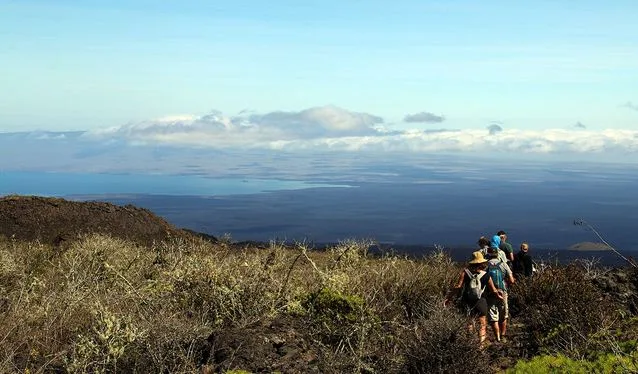
Text & photographs by John Keeble
A sleek, grey shadow emerged from among the volcanic rock life below the Galápagos waves, hugging the side of a curving wall and slipping past me with an elegance of a superb creature in its element. It was a shark, about a metre long and an arm’s length from me.
As I turned to watch it disappear into the distance, a giant marine turtle swam past in deeper water with dignified ease. Everything made way as it looked neither right nor left.
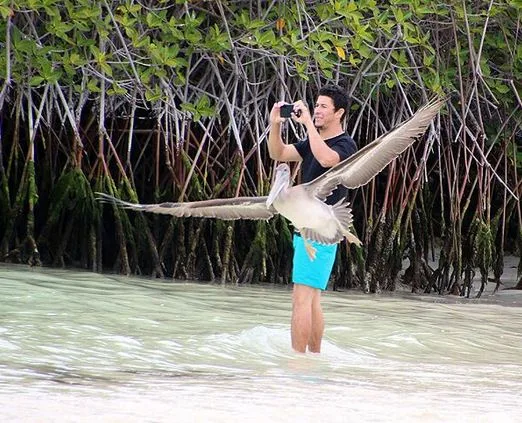
People and wildlife, the story of the Galapagos.
All around, there was life – something I vaguely expected when above the slate-grey waves but was fascinated to see when, as a novice snorkeller, I was under the surface.
The floor and rising walls were sparkling with flora: greens, pinks, reds and blues bouncing light off the colonised rockscape. Fish competed with their own iridescent yellows, reds and blues among the soft-hued browns and greys in a myriad of shapes and sizes.
A 20-minute boat ride away, in a coastal volcanic moonscape, blue-footed boobies nested and small groups of tourists danced over risky makeshift routes to see and photograph them. If the boobies noticed this strange ritualised behaviour, they never let on – they certainly showed a lot less interest in the tourists than the tourists showed in trying to glimpse the boobies’ elusive mating dance.

Got it! Our photo of a blue-footed booby.
Back in the tourist nesting areas of my chosen island, Isabela, a million years have built enough soil, sand, flora and fauna to make it a pleasant human habitat. In November, the end of the low season before the December-February rush of visitors, there were calm walks among the giant tortoises and hikes up to the rim of the nearest volcano, Volcán Sierra Negra, and down into its lava fields from eruptions in the late 19th century and in 1963.
The volcano hike was like taking a thin slice of nature’s evolution: the older Sierra Negra lava flow was sparsely colonised by cacti, ground hugging plants and a few trees… a step beyond, literally, the 1963 field was almost bare of flora as nature struggled to get a toe hold.
Earlier, I had travelled from Cuenca to the main Galápagos tourist destination, Santa Cruz, with hiking and biking buddies Shahbaz Khan, Neal Adams, Linda Todd Murphy, Ric Shellhammer and Bob Horowitz. We stayed in an Airbnb house near the Puerto Ayora harbour and spent a week exploring the coast and inland walks.
Oddly for a vegan, one of the most fascinating aspects for me was the interaction between local people, sea lions and pelicans at Puerto Ayora’s quayside fish market. They all worked together to meet the needs and clear up the waste, though it was endearingly strange to see a sea lion leaning against a fish worker like my dogs have leaned against me. Nearby, on the pelicans’ inbound flight path, a notice (like many others) warned against contact with wildlife.
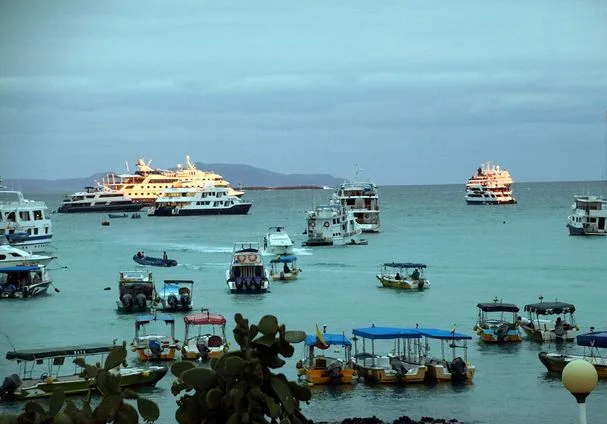
Sunset lights up cruise ships in Puerto Ayora.
Santa Cruz Island, with a 12,000 permanent population, is the tourism hub of the Galápagos islands, with Isabel (four times its size) to the west and the smaller San Cristobal further away to the east. It welcomes most visitors to Puerto Ayora, its busy town and port from which powerboat ferries ply.
The Charles Darwin centre, with its educational role and giant tortoises, is a must visit for Santa Cruz tourists. In addition, there are many sea and land opportunities to see wildlife in its environment. Scores of restaurants and souvenir shops compete to welcome tourists. Travel offices offer sightseeing and activities further afield, including huge “last minute” discounts on cruises.
As the rest of my group headed back to Cuenca, I gave my camera a treat with an extra week on Isla Isabela, the biggest of the islands and four times the size of Santa Cruz. The two-hour powerboat crossing was excitingly wild, contrasting with the gentleness of Isabela’s Puerto Villamil. The laid-back village mood there was set immediately by marine iguanas basking on the jetty’s access path and sea lions barely working up the interest to glance at flocks of humans migrating from colder climes.

Yeah, well, it’s another pelican, isn’t it?
I stayed in a modest and pleasant property on a beach that stretched maybe four kilometres. Pelicans flew, dived, ate… small waders searched the shallows… the occasional tourist strolled. The village, home to 800 permanent residents, offered restaurants, shops, a church, sandy walks on quiet streets.
The longest road, running parallel to the beach, led to a linear park with volcanic lava sights and, at the end, the enormous Wall of Tears build for no practical reason by forced labour when the site was used as a harsh penal colony from 1946 to 1959. It is said to have cost thousands of lives.
Some people, like me, chose to walk the park’s 5km path to share the experience with giant tortoises, iguanas and many kinds of birds including the Darwin finches. Other people chose to rent bicycles in Puerto Villamil and ride.
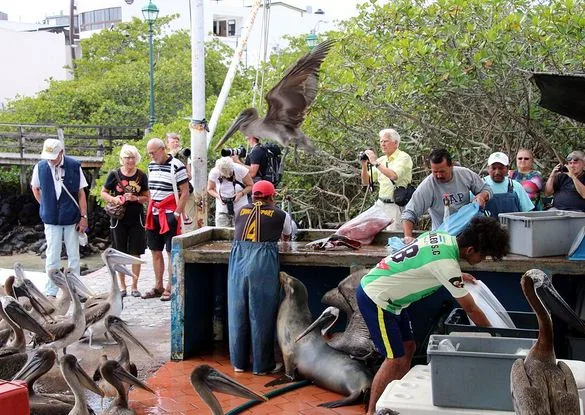
Sea Lion and pelicans wait for their share at fish market in Santa Cruz.
The Galapágos protected reserve stretches over 138,000 square kilometre with 13 volcanic islands. Since all the volcanos are still active, it is one of the most volcanic areas in the world. The islands’ spread-out nature means cruising offers the means of seeing more of them.
There is a tension between the preservation of the islands and the pressures of the 21st century. Ecuador needs the income from its greatest tourism attraction but it is conscious of the need to preserve the environment and wildlife. The number of people living on the islands, including illegals, and visitor numbers cause concern. Earlier this year, the authorities tightened regulations on tourists who now need to prove they have return flights, accommodation booked, and park permits to enter (the permits can be purchased at Quito and Guayaquil airports serving the Galapagos). Local environmental measures include a waste disposal system, with more than half going into landfill and the rest sent 600 miles by sea to mainland Ecuador for recycling. The navy patrols the sea but, even so, illegal fishing is a problem.
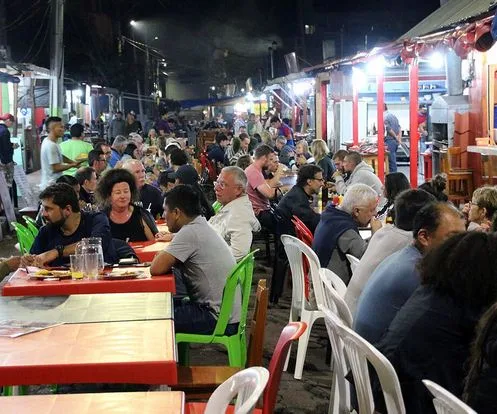
Eat street in Puerto Ayora, Santa Cruz Island.
For visitors, the protection of wildlife and the unique Galapágos ecosystem plays out as restrictions on areas open for visits and a ban on interaction with wildlife.
I travelled to the Galapágos with conflicted feelings: I wanted to see the wildlife and terrain but I was conscious that the very act of seeing it, being part of the tourist flow, must risk its existence. I left feeling that the islands and sea were being carefully preserved and hoping they will be protected for the benefit of the wildlife and ecosystem that draws us there.
How do you want to see the Galapagos?
The choices come down to two main types of visit: island-based or cruising. Generally, island based trips cost far less than cruises but do not get visitors to more remote areas; and cruises, which can get to places where others cannot go and consequently have the potential to see more, are an expensive luxury. Here are some experiences:
Cruising the Galapagos
By Danica Robertson
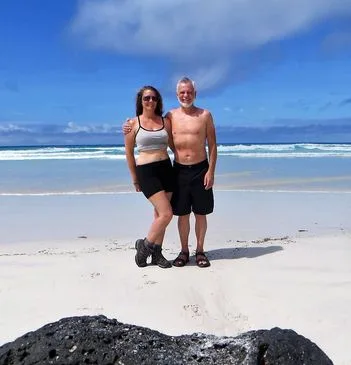
Danica and Ron Robertson
After much research, my husband Ron and I opted to take a cruise to explore the Galapágos as it gave us access to more remote islands. This is a more expensive option than island hopping, but we didn’t have to worry about meals, itineraries and other logistics. (Be prepared for tipping expectations: we paid $25 per day, per person, for the guide and the crew.) The guide’s knowledge and experience definitely enhanced our trip by giving us historical and environmental insight. Our days were jam packed with snorkelling, hiking and great meals. We swam with manta rays, sea lions, sharks, penguins and turtles. Hiking took us to the nesting areas of blue-footed boobies, frigates, sea turtles and albatross and historic sites. It was all we hoped for and more.
It was an eight day cruise (though Day 8 was only a few hours) and we paid $2500pp. We booked a month in advance, saving $1300pp on the advertised price, but could have saved more if we’d waited longer (assuming it was still available). Tips added $400 to the total paid.
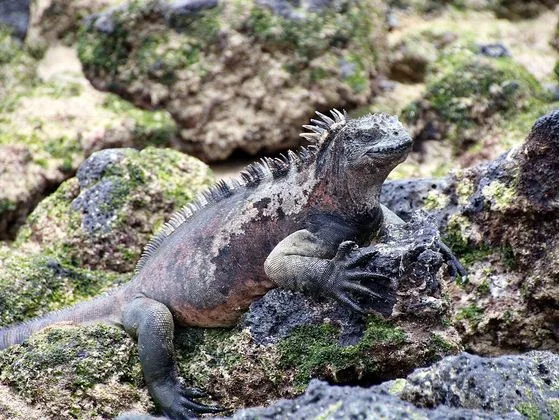
Iguana on Santa Cruz Island
Island-based visit: Much of the adventure of the island-based opportunities is covered in the main article but, in addition, island trips offer more personal freedom than cruise programmes. However, they are harder work and mostly limited to more accessible sites.
Two of the islands, Santa Cruz and Isabela, have air services from the mainland and light aircraft link those islands and San Cristobal.
Island hopping is easy on the powerboat ferries with tickets from around $25 one-way and the length of stay on each island is open to your decisions. Crossings can be bumpy (do not sit at the back if you want to stay dry).
The practical side of life, like eating, has more choice on islands – though meals and drinks often cost more than double mainland prices. Transport and finding locations to visit can be physically harder than taking a cruise.
I felt that I had seen enough to make it a very satisfying visit. I plan to return at some stage – one of the advantages for those of us lucky enough to live in Ecuador is that it does not have to be a ‘once in a lifetime’ trip. I spent about $1,300 over 14 days in which I focused on making the most of the visit rather than saving money.





















